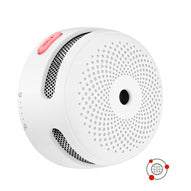How to Choose the Right Fire Detectors
Thu, May 27, 2021
When people hear about fire alarms, they tend to assume about loud screaming sound and flickering lights. While no one likes hearing a fire alarm, some people acknowledge their value and initiate evacuating the premises right away. The use of fire alarm devices can save human life. Their quality and reliability is dependent on getting a sensor system with the proper kind of fire detectors.
Know More about Fire Detectors
Fire detectors are applied to sense any of four fire properties: heat, smoke, ignition gas, or infrared or ultraviolet emission. If any of these features is detected, detectors would initiate an alarm system. There are many varieties of detectors present that are equipped to activate a fire alarm device. Smoke detectors are by far the most popular, but there are also heat detectors, beam detectors, CO detectors, air aspiration detectors, flame detectors, and other types.
Depending on the kind of detectors used, these fire detection systems fell into three broad groups:
- Smoke detector
- Fire gas detector
- Flame detector
1. Smoke Detectors
For the detection of smoke, two kinds of sensor technologies are being used: optical (also known as photoelectric) technologies and ionization, which in itself is a physiological method.
Optical (photoelectric) technology converts light into some kind of electric charge using a source of light, a device for the correlation of the light from that light source (converting it into a continuous beam of light), as well as a photoelectric sensor. When smoke enters the system's darkened optical area, which passes through the beam of light. The molecules present in the smoke interrupt the beam, causing it to "disperse." The photoelectric sensor can detect the scattered light and raises it's own power output to activate the warning.Optical (photoelectric) smoke alarms are helpful in detecting scorched fires which produce a large amount of smoke however no noticeable flames. They are, nevertheless, susceptible to soot and sediment, which could also accumulate in the device and cause faulty signals.
Ionization sensors operate by getting a small quantity of radioactive particles (Americium-241) across two electrically powered sheets. The radioactive substance's emission generates a slight charge (ionizes) between its two sheets, ionizing the atmosphere. Smoke approaching in that area absorbs the alpha molecules, interrupting the flow of electrons and reducing ionization, causing the signal to ring.
Ionization smoke detectors are able to detect extremely small molecules, which are common in smoke from fast-moving, burning flames. but nevertheless they are, slow in responding to fiery fires even their optical duplicates, can trigger incorrect alarms as dust, dirt, as well as other molecules accumulate within them.
2. Flame Detector
Heat emission or the conversion of released in the process in the form of electromagnetic radiation, is emitted by open flames and fires. Flame detectors have an electrical circuit that includes an electromagnetic energy receptor (the sensor) that can measure energy at one or perhaps more specified wavelengths mostly on electromagnetic spectrum. Whose receptors are developed to detect changes in heat radiation beyond a certain level either with ultraviolet (UV) or infrared (IR) emissions. The wavelengths of UV and IR are not the same. As a result, flame detectors are classified according with the kind of emission they are intended to identify.
UV flame sensors are used to identify ultraviolet radiation, that has noticeable deviation between the wavelength of 10 to 400 nanometre upon its electromagnetic spectrum. They are designed to detect variations in radioactive levels of atmospheric. The UV sensor senses a rise in radiation and activates the detector whenever a fire starts. In less then milliseconds, UV detectors can precisely differentiate the form of flames present at the time of ignition. UV sensors may be activated by many other UV factors, such as sunshine and thunder, due to their susceptibility. To reduce false alarms, many UV sensors have a 2-3 second lag designed in.
Only within infrared spectrum, infrared flame sensors are equipped to track the heat emission produced by open flames (700 - 1,000,000 nanometre). To convert infrared energy to visible spectrum, a portable thermal processing scanner inside the system analyses wavelength variations. IR sensors, while not as quick as their UV equivalent, have very quick reaction speed, among most capable of identifying in 3-5 seconds.
3. Fire Gas Detector
Based on the type of product that is burning, fires can release a number of gases, the majority of which remain extremely poisonous and/or rapidly deprive the supply of oxygen in a confined room. Carbon monoxide, carbon dioxide, nitrogen dioxide, sulphur dioxides, sodium chloride, ammonia, hydrogen bromide, hydrogen cyanide, ammonia, as well as certain other gases are examples of such gases.
The aim of fire gas detectors is to be able to identify specific gases at predetermined quantities. As a result, systems must always be chosen depending on the particular kind(s) of gases that may exist in the presence of the combustible materials.Infrared points sensors, ultrasonic sensors, electro - chemical gas receptors and semiconductor sensors can also be used by gas detectors on various platforms. Furthermore, since they are designed to identify particular gases, you can center your decision on the basis of gas they sense. Then you should assess the technology and see which is better for the situation.
As you've seen, no specific fire detection system is equally usable in every scenario. They all have their very own set of advantages and disadvantages, as well as the numerous conditions and situations in which they would be required.
You may also like:

X-Sense XS01-WR Wireless Smoke Detector
- Wireless technology uses radio frequency to transmit and receive messages.
- If one alarm goes off, the rest of the interconnected alarms will alert as well.
- 5-year replaceable battery and 10-year sensor life.
- Advanced photoelectric sensor is more sensitive and reduces false alarms.
$35.99







